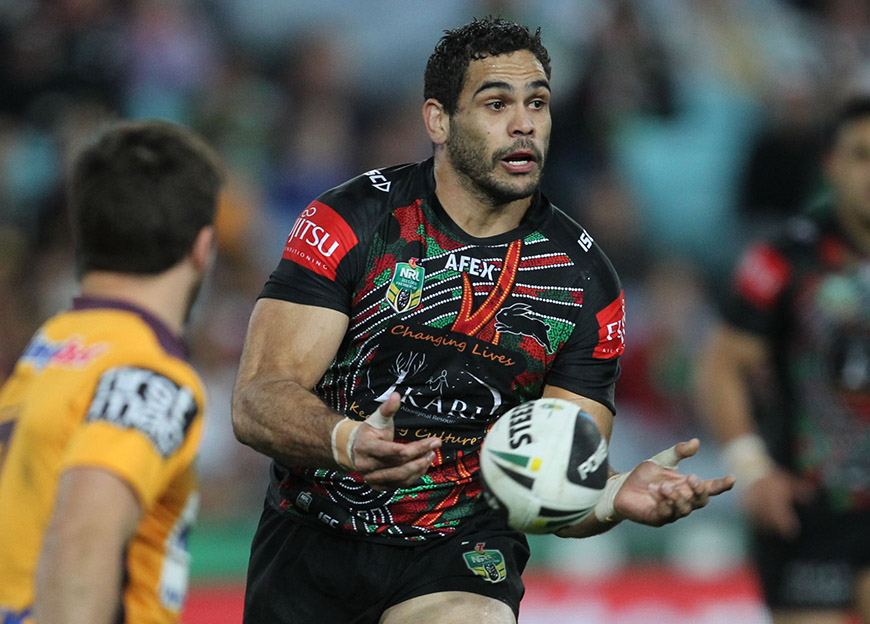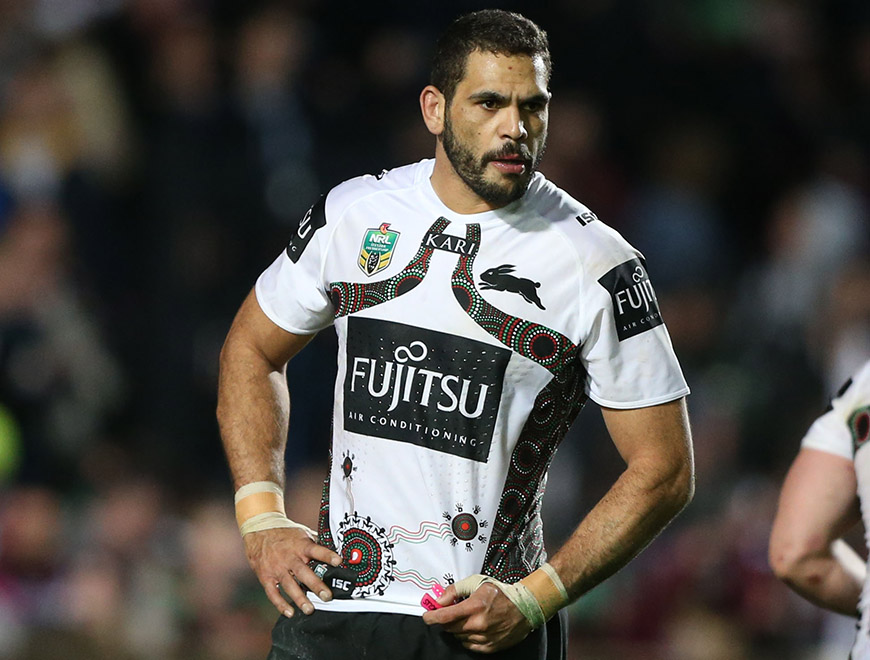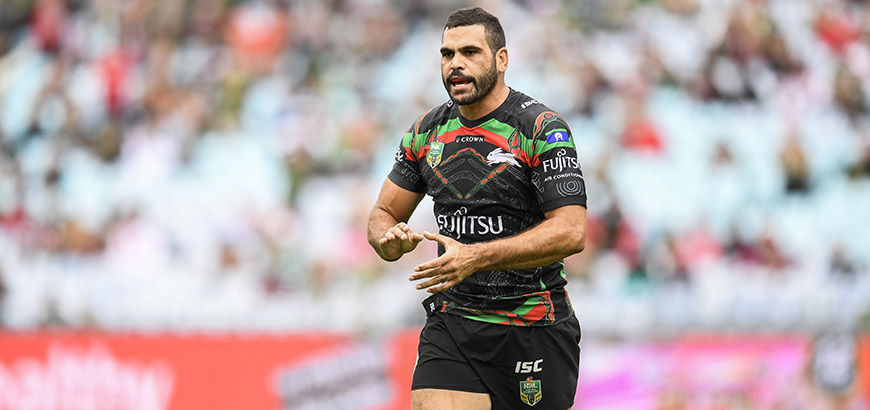Indigenous/Close the Gap Round Jerseys
2012
The Rabbitohs wore a special Indigenous jersey for the ‘Close the Gap’ match against the Titans in round 22. The Club commissioned local artist Daren Dunn to design a jersey that reflected South Sydney’s long-standing relationship with the Indigenous community and their links to the heartland at Redfern.
Meaning and symbolism behind the jersey design includes:
- The black and white rabbits represent the Aboriginal and non-Aboriginal people and players of Redfern and South Sydney's local community;
- The black hands represent the Aboriginal Elders of the past and present;
- The green and red boomerangs on the front of the jersey represent the youth of today.
- The seated figures near the black hands represent the spectators and supporters of the teams.
- The meeting places are ceremonial sites in South Sydney.
- The white dots running through these sacred sites are our connection to the land and people of this nation.
- The people and places represented in this story come together as one.
- The side panels depict a celebration.
- Red and green dots are scattered to represent the stomping of the dust as the welcome dance takes place. Tribes call this the ‘Welcome Shake a Leg dance.’

2013
The Sid Domic-designed jersey was worn in Round 23 against Manly-Warringah as part of the NRL’s Close the Gap round.
The Domic design incorporated Aboriginal dot painting into the traditional Rabbitohs jersey design.
The design was a reflection of the Rabbitohs’ long-standing relationship with the Indigenous community, as well as serving to recognise the contribution of current and former Indigenous Rabbitohs to the Club and the wider community.

2014
For the second year in a row, the Rabbitohs wore a jersey designed by former NRL player Sid Domic. The Rabbitohs wore this jersey in round 23 against the Brisbane Broncos in the designated Close the Gap round.

2015
2015 saw the Rabbitohs don their fourth Indigenous-themed jersey in four years. They wore the jersey in Close the Gap Round, round 22 against the Sea Eagles.

2016
The 2016 Indigenous jersey was designed by Sydney-based Indigenous designer, Nikita Ridgeway, and told the stories of six of the Club’s Indigenous players including captain Greg Inglis, Indigenous All Stars representatives Kyle Turner, Alex Johnston, Chris Grevsmuhl and Dane Nielsen, as well as Rabbitohs 2016 debutant Cody Walker.
The jersey featured the hand prints, tribe names and totems of the six players, with the players having input into the design of the jersey.
The design told the players’ personal stories as proud Indigenous men, and how their learnings about their culture and background have shaped their lives.

2017
The Rabbitohs’ Indigenous jersey was designed by Aboriginal artist Joe Walker, the uncle of Rabbitohs five-eighth Cody Walker.
The Rabbitohs’ Indigenous players are represented by their totems on the jersey. The totems are all connected together by a red and green link, symbolising unity amongst the players, and the totems were linked back to the rabbit, symbolising the players’ strong links with the Club.
The players were involved in selecting the final artwork. They decided on the above story to be told through the totems and the rabbit.

2018
In 2018, seven of the South Sydney Rabbitohs’ Aboriginal and Torres Strait Islander players worked closely with artist Dennis Golding to create a jersey that symbolises who we are.
The charcoal body is dominated by the powerful outlines of the five totems that represent our Aboriginal and Torres Strait Islander players’ heritage: the crocodile, the praying mantis, the long-necked turtle, the hammerhead shark and the goanna. The players represented were Greg Inglis, Braidon Burns, Tyrell Fuimaono, Dane Gagai, Alex Johnston, Kyle Turner and Cody Walker.
To acknowledge those that walked before us and those who stand with us today, customary designs of Indigenous artwork, including snakes and boomerangs, adorn the trim of the jumper.
Red and green flashes that signify the traditions of South Sydney surround a classic white rabbit stamped on our chest.
The flags of the Aboriginal and Torres Strait Islander peoples fly proudly on our shoulders to frame a Rabbitohs jersey that shapes our identity.
With our heart on our sleeve and our story on our body, this was our 2018 Indigenous Round Jersey.

2019
The South Sydney Rabbitohs wore a specially-designed jersey for the 2019 Indigenous Round, celebrating the Indigenous culture that is ingrained within the Club, as well as the proud Aboriginal and Torres Strait Islander players and ambassadors that represented the Club each week.
The jersey was designed by Indigenous artist and uncle of Cody Walker, Joe Walker. Joe is a proud Wahlabul man of the Bundjalung Nation on the far north coast of New South Wales.
The jersey maintained the traditional red and green hoops of the South Sydney jersey which spans back to Rugby League’s foundation season of 1908, however the hoops are made from a sprawling dot painting that covers the entire jersey. The circles and lines that feature in the design represent the Club’s connection with the ocean in the east through to the land in the west.
Six players and ambassadors of Indigenous heritage represented the Rabbitohs in 2019, those being Indigenous All Stars captain Cody Walker, Indigenous ambassador Greg Inglis, Dane Gagai, Kyle Turner, Alex Johnston and Braidon Burns.
The six players’ and ambassadors’ handprints were featured on the jersey, and within those handprints were depictions of their totems. Those totems are the goanna (Walker and Turner), the praying mantis (Inglis), the shovel-nosed shark (Gagai), the crocodile (Johnston) and the emu (Burns).
2020
The Rabbitohs wore a specially-commissioned Indigenous jersey which highlighted the Club’s proud Indigenous heritage and its respect for Indigenous culture.
Designed by renowned and respected Indigenous artist, Uncle Joe Walker, the jersey featured the handprints and totems of the Club’s eight NRL players as well as animal tracks of those totems connecting back to the central black rabbit representing the different communities, players and their stories.

2021
The Rabbitohs wore their 2021 Indigenous Jersey against the Panthers in Dubbo, commencing a fortnight of celebrations around the Aboriginal and Torres Strait Islander cultures which are woven into the fabric of the South Sydney club.
The jersey design was facilitated by Uncle Joe Walker, an Aboriginal artist from northern New South Wales and the uncle of Rabbitohs player Cody Walker, and was designed by seven participants from Souths Cares’ community programs - Imogen Grant, Mia Gregory, Tyreece Lyons, Melodey Roberts, Adrian Scanlon, Jayden Simms and Natalie Travato.
The designs on the front of the jersey depicted the totems of the sand goanna and the whale which represents the Redfern and La Perouse areas respectively, highlighting the Countries on which the Rabbitohs lived and worked each day.
The same elements were repeated on the back of the jersey, along with the footprints of the seven Aboriginal and Torres Strait Islander players that represented the Rabbitohs’ top squad – Cody Walker, Latrell Mitchell, Alex Johnston, Dane Gagai, Braidon Burns, Troy Dargan and Joshua Cook.
Aboriginal Warrior, Pemulwuy, was also represented having led a resistance against settlers and fought for his land in 1790.
Along the sides of the jersey were the handprints of the young Souths Cares designers that assisted with the creation of the design.
The Rabbitohs wore the Indigenous jersey in two back-to-back matches against the Panthers at home at Apex Oval in Dubbo and against the Parramatta Eels in the NRL’s Indigenous Round at home at Stadium Australia in round 12.
2022
The South Sydney Rabbitohs 2022 Indigenous Jersey honoured our matriarchs – our mothers and all women.
The jersey was designed by Uncle Joe Walker, a proud Wahlabul man, who designed the Rabbitohs Indigenous jersey for the fifth time in 2022.
Depicted on the jersey was the birthing tree which symbolised our matriarchs and acknowledged that everything comes from Mother Earth. The players’ totems were featured at the trunk of the tree which symbolised that everyone is part of the foundation of our communities and that everyone has a role to play in helping the tree to flourish. The totems representing the players were:
- Goanna – Cody Walker (Yuin and Bundjalung) and Latrell and Shaquai Mitchell (Wiradjuri - maternal totem)
- Shark – Latrell and Shaquai Mitchell (Biripi - paternal totem)
- Crocodile – Alex Johnston (Saibai Island)
- Black-tailed Kangaroo – Isaiah Tass (Yuwi)
- Whale – Blake Taaffe (Bidjigal)
The red colour on the jersey represented the blood in our veins and red earth we live on and the green represented the natural beauties of our land. The red and green also represented the Rabbitohs and their connection to people right across our countries. The river represented our song lines and individual journeys as Aboriginal and/or Torres Strait Islander people. The circles represented our people coming together as one. Many Aboriginal and/or Torres Strait Islander clan groups come together to yarn and share in support of the Rabbitohs.
In addition, the Aboriginal and the Torres Strait Islander flags highlight the sleeves of the jersey.
The jersey said we are all part of the Rabbitohs family. We all become one.
2023
The 2023 Rabbitohs Indigenous jersey was once again designed by Wahlabul man Uncle Joe Walker, along with his two daughters.
The design was inspired by the 2023 NAIDOC theme – For our Elders.
The design features two Elders, a Uncle and am Aunty, on the sides of the front of the jersey. The six silhouettes and totems depict the six Indigenous players in the first grade squad. Those players are:
- Cody Walker – Bundjalung and Yuin – goanna
- Alex Johnston – Saibai Island – crocodile
- Latrell Mitchell – Biripi and Wiradjuri – shark and goanna
- Shaquai Mitchell – Biripi and Wiradjuri – shark and goanna
- Isaiah Tass – Yuwi – black tail kangaroo
- Blake Taaffe – Bidjigal – whale
The open hands indicate the silhouettes are passing down and sharing stories and knowledge amongst the generations.
The boomerangs show the holding of that knowledge which has been passed down for thousands of years.
The circles represent the yarning at the meeting places and the teaching that goes on with young people to take them on their journey.
Everything is set around the central rabbit, showing all of the different countries moving towards, and arriving at, the Rabbitohs.























































